As some of you know, I'm reading bios on the children of Queen Victoria of the United Kingdom. Recently I finished one on her eldest child: Victoria Adelaide Mary Louisa, who was born on November 21, 1840, 9 months after her parents' wedding. Soon styled "The Princess Royal," historians consider Vicky the brightest and most precocious of Queen Victoria's 9 children. Starting as a toddler, she received many of her school lessons from her brilliant father, Prince Albert, who also doted on her. The child spoke fluent French at 18 months of age.
Vicky fell in love with the husband her parents selected for her, the liberal, university-educated Crown Prince Frederick of Prussia, and it was hoped their union would bring a liberal, democratic Germany and England close together. |
| Victoria with Wilhelm (II) and Charlotte |
The bio, Uncommon Woman, is thoroughly researched. Its author, Hannah Pakula, knows the era's, as well as, the Prussian Court's complicated history and intrigues; and she uses primary sources, as opposed to, relying on what others have said, to write it, which is a strength. Since Prussia's ultra-conservative politician, Bismarck, methodically plotted to rob Vicky and her liberal-minded husband, Fritz of their rightful places in history (and his Realpolitik diplomacy made the world ripe for WWI) I understand why the author needs to include the German Chancellor as part of the storytelling, but sometimes Crown Princess Victoria gets lost in the book because of it.
Relationships you the reader, want to know more about in a Vicky bio get abridged: Prince Albert's love for his eldest daughter; her happy marriage to Fritz; her sometimes challenging relationships with her 3 oldest children: Wilhelm (1859), Charlotte (1860) and Henry (1862); her easier relationships with her 3 youngest daughters: Victoria (1866), Sophia (1870) and Margaret (1872); and the devastating deaths of her two youngest sons {and middle children}: Sigismund (1864) and Waldemar (1868), are all reported, yet are surprisingly not that intimate, lacking the details. Sometimes Vicky's more personal affairs are mentioned in a paragraph, while entire chapters on Bismarck and the diplomacy of foreign countries (France, Russia, and England) go on for several chapters in full detail.
Also, I know from other books, Crown Princess Victoria saw her siblings over the years, but the visits and sibling relationships are barely mentioned in this book. And too, her remarkable intelligence, talents, kindness, and perseverance are touched upon, but again leave a reader wanting.
 |
| Vicky is holding Sigismund. |
Relationships you the reader, want to know more about in a Vicky bio get abridged: Prince Albert's love for his eldest daughter; her happy marriage to Fritz; her sometimes challenging relationships with her 3 oldest children: Wilhelm (1859), Charlotte (1860) and Henry (1862); her easier relationships with her 3 youngest daughters: Victoria (1866), Sophia (1870) and Margaret (1872); and the devastating deaths of her two youngest sons {and middle children}: Sigismund (1864) and Waldemar (1868), are all reported, yet are surprisingly not that intimate, lacking the details. Sometimes Vicky's more personal affairs are mentioned in a paragraph, while entire chapters on Bismarck and the diplomacy of foreign countries (France, Russia, and England) go on for several chapters in full detail.
 |
| Victoria, an excellent rider, here with Wilhelm, 1861 |
Still Uncommon Woman is a must-read because it's probably the best, most comprehensive, and scholarly book on Empress Victoria to-date.
Fritz is not given the credit he deserves for turning the Germanies into one unified Germany (due to Bismarck's evil manipulation of the press). Nonetheless, husband and wife were soul mates; both intellectuals and accomplished; and they lived with a sense of great purpose.
[Christina Croft, the author of several books on Queen Victoria's family, thinks Victoria, the Princess Royal, would have made a great British Queen, and I agree. A pity the era did not give Queen Victoria's most gifted and firstborn child the chance.]
[Christina Croft, the author of several books on Queen Victoria's family, thinks Victoria, the Princess Royal, would have made a great British Queen, and I agree. A pity the era did not give Queen Victoria's most gifted and firstborn child the chance.]
 |
| Queen Victoria's Diamond Jubilee in 1887: In the carriage are Queen Victoria with her daughter Crown Princess Victoria of Prussia. Sitting opposite are Princess Beatrice and Prince Alfred. |
Twelve years after her husband, German Empress Victoria died at age 60 on August 5, 1901, of breast cancer. For history, she left behind a lifetime of insightful correspondence with her mother, Queen Victoria. (Her brother, Edward VII on a visit to his dying sister, arranged via his private secretary to smuggle her letters out of Germany into England. The royal family was afraid the new Kaiser Wilhelm II might destroy them.)
In the 20th and 21st centuries, Empress Victoria's descendants became kings and queens of Spain, Greece, Romania, Yugoslavia and of course, Germany.
You may also enjoy:
Queen Victoria's Family Pictures
Princess Alice Of The United Kingdom
Remembering Prince Leopold, Duke Of Albany
Queen Victoria & Prince Albert: Books & Series
In the 20th and 21st centuries, Empress Victoria's descendants became kings and queens of Spain, Greece, Romania, Yugoslavia and of course, Germany.
 |
| At age 14, Victoria, the Princess Royal designed and hand-painted this fan for her mother, Queen Victoria's birthday. Click the image to see the amazing details. |
You may also enjoy:
Queen Victoria's Family Pictures
Princess Alice Of The United Kingdom
Remembering Prince Leopold, Duke Of Albany
Queen Victoria & Prince Albert: Books & Series








